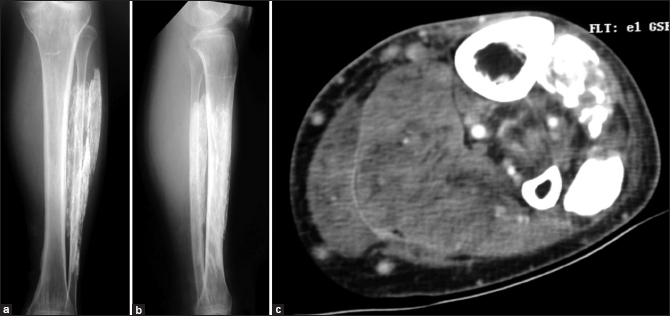Translate this page into:
Case of Leg Pain
Corresponding Author:
Nizar A Al-Nakshabandi
Department of Radiology, College of Medicine, King Saud University, Riyadh
Saudi Arabia
nizar97@hotmail.com
| How to cite this article: Al-Nakshabandi NA. Case of Leg Pain. J Musculoskelet Surg Res 2020;4:113-114 |
History
A 60-year-old male presented with leg pain and swelling that is increasing gradually with time. The pain is not severe. He has a medical history of tibial fracture of the same leg.
- What are your radiological findings?
- What is the differential diagnosis?
- What are the possible causes?

Findings
The plain films A and B demonstrate fusiform masses of a peripherally oriented plate-like amorphous calcification. They are oriented in the sheet-like pattern and involve the muscles of the leg laterally.
Computed tomographic scan demonstrates the fusiform cystic lobulated components of this calcification, some of which have eroded into the bone due to their chronic nature.
Differential Diagnosis
The differential diagnoses of soft tissue calcification are as follows:
- Calcific myonecrosis
- Dystrophic soft tissue calcification (most common), e.g., chronic venous insufficiency
- Vascular, e.g., arterial calcification, phleboliths
- Metabolic, e.g., calcium pyrophosphate deposition (causing chondrocalcinosis), metastatic calcification, idiopathic tumoral calcinosis
- Autoimmune diseases, e.g., scleroderma, dermatomyositis
- Infection, e.g., cysticercosis
- Neoplasm, e.g., primary or metastatic osteosarcoma, synovial osteochondromatosis
- Trauma, e.g., myositis ossificans, tendonitis
Diagnosis
Calcific myonecrosis.
Pearls and Discussion
Calcific myonecrosis is a rare posttraumatic condition characterized by the vacuum formation of dystrophic calcification almost exclusively in the lower limb.
It is thought that the ischemia appears as a complication of compartment syndrome, resulting in calcific myonecrosis. The current hypothesis is that initial compartment syndrome decreases the circulation within the limited space, resulting in necrosis and fibrosis. After some time, repeated intralesional hemorrhage causes the mass to be enlarged and get calcified. The most common site is the lower leg with the anterior compartment most frequently affected.
Calcific myonecrosis is a benign diagnosis, and although it is uncomfortable and disfiguring, it should not prompt a biopsy as devastating results may occur. It is one of those conditions that should be considered a “do-not-touch lesion.”
Declaration of patient consent
The author certifies that he has obtained all appropriate patient consent forms. In the form, the patient has given his consent for his images and other clinical information to be reported in the journal. The patient understands that his name and initials will not be published and due efforts will be made to conceal his identity, but anonymity cannot be guaranteed.
Financial support and sponsorship
Nil.
Conflicts of interest
There are no conflicts of interest.
Further Reading
- O'Dwyer HM, Al-Nakshabandi NA, Al-Muzahmi K, Ryan A, O'Connell JX, Munk PL. Calcific myonecrosis: Keys to recognition and management. AJR Am J Roentgenol 2006;187:W67-76.
- Holobinko JN, Damron TA, Scerpella PR, Hojnowski L. Calcific myonecrosis: Keys to early recognition. Skeletal Radiol 2003;32:35-40.
- Snyder BJ, Oliva A, Buncke HJ. Calcific myonecrosis following compartment syndrome: Report of two cases, review of the literature, and recommendations for treatment. J Trauma 1995;39:792-5.
Fulltext Views
1,507
PDF downloads
1,100





